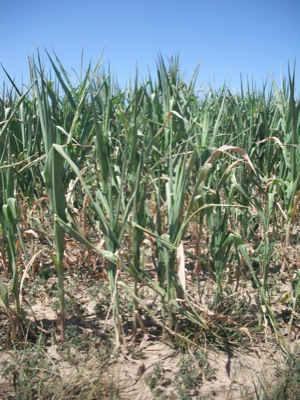Thursday, July 12th, 2012
Drought may halve yield
Corn crop dire, still hope for beans
By Nancy Allen

Photo by Nancy Allen/The Daily Standard
Corn along state Route 197 north of Celina is short, curled and already tasseling on Wednesday. Local ag officials said the corn crop could be reduced by as much as 50 percent due to the drought. Inset: Steve Niedbalski holds an ear of corn Wednesday in Nashville, Ill. Due to the poor condition of the corn, he was chopping it to make silage.
Almost a third of the nation's corn crop is showing signs of damage due to drought.
Locally, ag officials are predicting yields could be cut by as much as 50 percent. Anita Green, executive director of the Auglaize County Farm Service Agency, called the situation "serious."
This year has the potential to be as bad as the notorious 1988 drought, which resulted in some farmers not being able to harvest any corn at all, she said.
"Yes, I think it could get that bad this year because we have a historically hot and dry period ahead," Green said. "It seems like all of a sudden it's fresher and cooler, but it's still dry."
Jim Hoorman, Mercer County OSU Extension educator, said corn does not grow well when temperatures get above 95 degrees; the ideal growing temperature is 75-80. The area has had several 100-degree days.
"A lot of the corn is at different stages, but the majority is starting to tassel and silk and that's a critical stage for corn," Hoorman said. "You need moisture at that time, and we're not getting it."
The situation could be particularly bad for cattle farmers, who grow their own corn, hay and forage to feed their animals. Corn that is too poor for grain likely will be chopped for silage and fed to cattle. Many will have to purchase feed, an added expense, Hoorman said.
How much this will affect food prices is still unknown, but it's likely consumers will see increases.
The cost of meat is most likely to be affected because the higher cost to feed cattle is usually passed along in the price of hamburger and steak. But meat prices were already rising and were expected to stay high after last year's drought in Texas forced many ranchers to reduce their herds.
Corn also is used as an ingredient in many items - from corn flakes to ketchup, bread and soda pop - but it accounts for a small fraction of the costs compared to such things as transportation and marketing.
The government already has predicted food prices will increase this year by as much as 3.5 percent. It won't be clear until the fall, when all the damage is known, how much the crop loss will add to that, Richard Volpe, a USDA food markets research economist, said.
The USDA on Wednesday said it expects farmers to get 146 bushels per acre this year, rather than the 166 bushels per acre it predicted at the beginning of the year. They will harvest an estimated 12.97 billion bushels of grain, a 12 percent reduction from an estimate in June of 14.79 billion bushels.
But even with that loss, farmers may still do better than they would have 10 years ago because plant breeders have developed corn varieties better able to withstand drought. The average yield in 2002 was about 129 bushels per acre.
Even farmers who lose much or all of their corn this year are unlikely to go under. Most take out crop insurance to cover weather-related losses.
Chris Gibbs, executive director of the Mercer County Farm Service Agency, urged farmers not to rush to sell their corn crop for silage or destroy it. He recommends farmers contact crop insurance agents before making any decisions that could adversely affect their insurance benefits or any USDA disaster payments that might become available.
"Don't make a bad situation worse by selling your corn crop for feed too cheaply or feeding it without knowing what you're getting," he said.
Hoorman said a larger amount of the county's corn likely will be made into silage starting this month. Farmers will cut it earlier than typical to ensure it has enough moisture to ferment properly and break down nitrates in the plant. Excess nitrates in silage can be toxic and cause cattle deaths.
Congress last year let expire USDA disaster programs that would have helped farmers recoup costs associated with pasture and hay, livestock and crop losses. The only federal relief that may come this year are emergency loans, but the USDA Secretary would first have to make a disaster declaration, which Gibbs and Green expect to happen. Both urged farmers to keep records of their losses in case Congress later passes ad hoc disaster assistance programs.
As for soybeans, one really good rain could turn that around, Hoorman said. Soybeans are much more tolerant of drought than corn and still have time to grow.
The positive side is farmers hopefully set back some money during the last few years of record commodity prices and decent yields, Green said.
"Farm income has been good, so there's a bit of a cushion there," she said.
However, many farmers spent money on additional land, rent, equipment and other improvements during those boom years.
"Hopefully they have secured the means to get through a rough time," she said.
- The Associated Press contributed to this story

